elassoma gilberti fry
#1
 Guest_Auban_*
Guest_Auban_*
Posted 02 October 2012 - 08:45 AM
towards the end you can see its heart beating.
http://s1242.photobu...1002_053623.mp4
#2
 Guest_EricaWieser_*
Guest_EricaWieser_*
Posted 02 October 2012 - 03:48 PM
#3
 Guest_gnod_*
Guest_gnod_*
Posted 02 October 2012 - 04:15 PM
what are your feeding regiments for the fry and the adults?
#4
 Guest_Auban_*
Guest_Auban_*
Posted 03 October 2012 - 01:57 PM
good news for anyone wanting to look at them under a microscope while they are still alive. they will stay perfectly still for you.
i just ordered a trinocular microscope with a camera, so hopefully i will be able to take better videos of them soon. i plan on watching this guys progress until he is free swimming and eating food.
#5
 Guest_Auban_*
Guest_Auban_*
Posted 03 October 2012 - 02:13 PM
http://s1242.photobu...1003_112651.mp4
oh boy... looking back at that video, i REALLY need that microscope to show up. my AO one fifty is a bit dated...
not the best setup for taking videos.
Edited by Auban, 03 October 2012 - 02:35 PM.
#6
 Guest_Auban_*
Guest_Auban_*
Posted 03 October 2012 - 02:32 PM
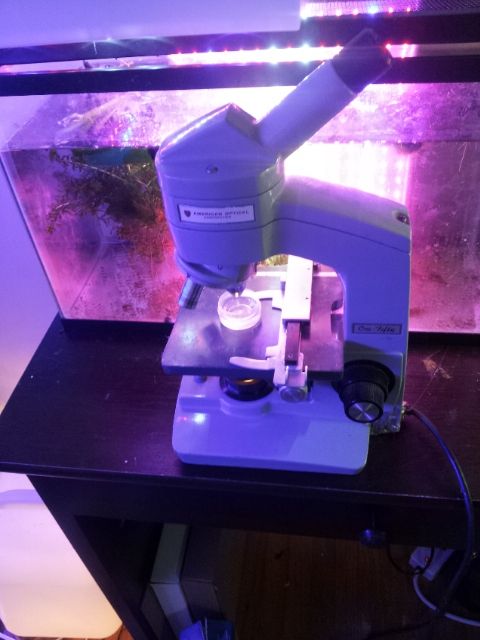
the little plastic container beneath the 10x is the temporary home for this fry. even though i have him in such a small container, it still takes me a minute to find him whenever i look. it was a bit easier this time though, since he is a bit darker than he was yesterday.
Edited by Auban, 03 October 2012 - 02:32 PM.
#7
 Guest_Auban_*
Guest_Auban_*
Posted 05 October 2012 - 06:19 AM
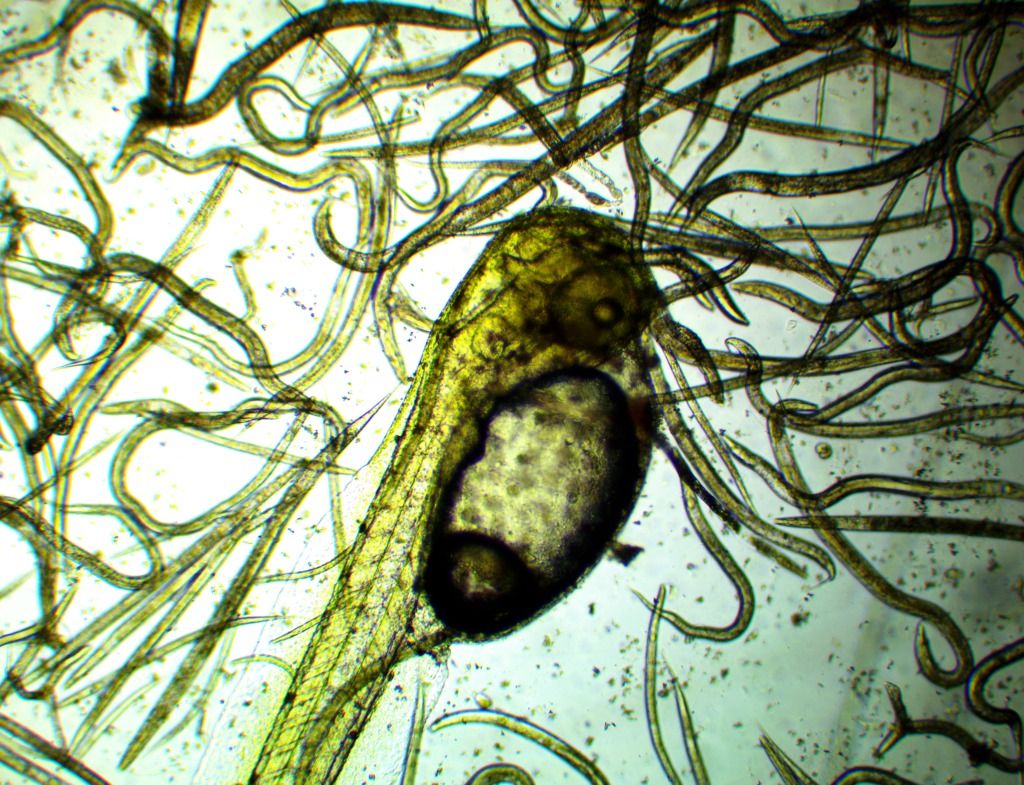
after seeing it, i think microworms, at least fully mature ones, might be a bit too big for elassoma fry...
now this pic was more or less a lucky shot. as much as elassoma fry refuse to move when they are still absorbing their yolk, they dont like to sit still for the camera once they are free swimming. again, 40x
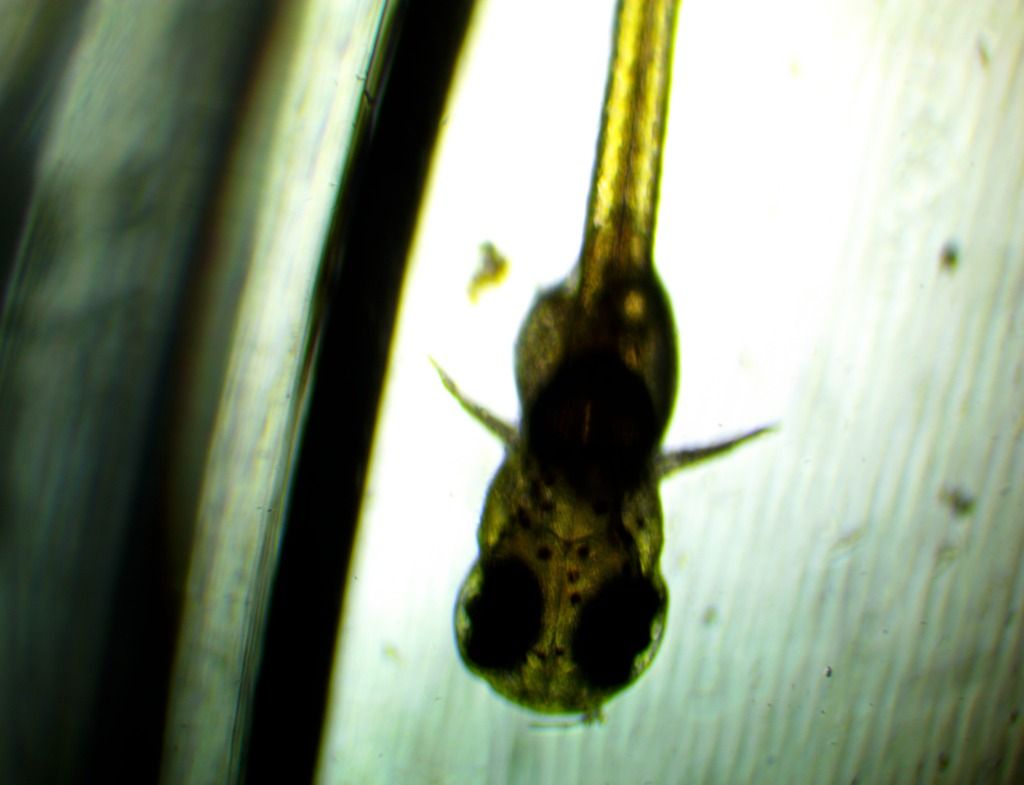
#8
 Guest_EricaWieser_*
Guest_EricaWieser_*
Posted 05 October 2012 - 07:15 AM
#9
 Guest_Auban_*
Guest_Auban_*
Posted 05 October 2012 - 07:39 AM
i have a small container with ten gilberti fry in it right now. since i added them, two have gone free swimming. unless they develop pigment in their stomachs as soon as they become free swimming, they are eating. there are microbes in the container with them that are about the size of their pupils, completely invisible to the naked eye.
i haven't fed them anything yet. right now i am waiting to see if the microbes (infusoria) will disappear or not. im also watching them to see if i can spot a fry eating one of the microbes.
i still believe, despite the results of your test, that a mature micro worm is too big for gilberti fry. the smaller worms look to be about the right size, but unless i see a brand new free swimming fry eat a fully mature microworm, i cant take your word for it. im ordering another culture of microworms, so ill start testing them out and watching them under the microscope. if i do manage to see one eat an adult microworm, ill be sure to try and catch it on camera.
thats something i would actually love to photograph...
#10
 Guest_EricaWieser_*
Guest_EricaWieser_*
Posted 05 October 2012 - 11:18 PM
The microworms I added to the water were scraped off the sides of the cultures, so unless the microlife could crawl up the side of the container or was present in large numbers in the half a cup of surface tank water I scooped out of the 55 gallon tank into the tupperware, I don't know how it would have gotten in there. The experimental setup was just an inch or two of water in a little tupperware box with fry and microworms in it.actually, i have a question about that... did you ever verify that there was nothing else in the water that the fry could have eaten?
No, I never put the fry culture water under a microscope. I just wanted to prove the fry were/weren't capable of eating the culture of microworms and the tank water that I had. Because they were, I was satisfied. Of course if you've been following my posts you'll see I recently admitted defeat. My culture of Elassoma gilberti has officially died out without any surviving males. So something was killing my fish. The babies weren't making it to adulthood. Maybe although they could find and eat the microworms in the tupperware setup, they were still starving to death in the tank itself. I dunno. I'll never know.
But I guess it doesn't matter if they eat mature microworms or not. If they eat juvenile microworms and/or baby microworms they might still be able to survive eating just microworms alone.
Edited by EricaWieser, 05 October 2012 - 11:20 PM.
#11
 Guest_Auban_*
Guest_Auban_*
Posted 06 October 2012 - 01:57 AM
But I guess it doesn't matter if they eat mature microworms or not. If they eat juvenile microworms and/or baby microworms they might still be able to survive eating just microworms alone.
i guess it doesnt, unless it is enough to foul the water, which is why i still want to try it and see.
i cant speak for your microworm cultures, but mine is loaded with other things. i hydrated the dead worms with distilled water and put them in a dish that had not been used before, so i cant see the microbes coming from anywhere else. whatever they are, they probably came in with the dessicated worms. either way, i would rule it out as a possibility. i also be willing to bet that something came in with the tank water.
so far as your fry no living in your 55 gallon, i cant imagine they were starving to death. once they grow even the slightest abount, they should have no problem eating microworms, and i can just about garauntee you have plenty of wee beasties swiming around at the bottom of the tank that they could eat. if they are not surviving, i believe there is another reason.
just out of curiosity, did you add any plants recently to the tank that could have come from an outdoor source? i ask because the one thing that i know of that will absolutely decimate fry, even in a large tank, are dragonfly and damselfly larvae. before i moved, i had a 20 gallon breeder that i added all my plant clippings and water to that i removed from my gilberti tank, much like i do now. when i got ready to move, i started taking the tank down, and to my surprise, i saw a fry. i spent hours carefully removing every strand of hornwort in the tank and inspecting each one, and then siphoned all the water though a fine mesh. i found four 1/3 inch damselfly larvae that i had no idea were in there, and five fry that were also about 1/3 inch. i then inspected the tank with the adult fish and found none. i assumed that any larvae were eaten by the adults.
on another occasion, i lost every fry in a relatively large betta spawn in about a week. after tearing the tank down, again inspecting each strand of hornwort, i found a single bright green dragonfly larvae that i somehow missed when i added the plants. shame on me... i set that tank up for my wife so that it would be easier for her to take care of the fry. they were her fish and she took my advice. attention to detail... attention to detail...
anyway, i just added the ten fry to a shallow dish. i will not be feeding them anything untill they are large enough to eat newly hatched ceriodaphnia. im going to test my suspicion that there is enough microbes in a typical tank to feed them. so, basically, i am just going to collect some of the moss and clado algae from my tank, rinse it in some of the tank water, and simply do small water changes every day. ill also be checking samples of the water i give them every day, as well as the water in their tray, just before doing water changes. ill be doing that to note any differences.
if the fry survive and grow, then i would assume that any established tank has enough food in it to support them, at least for a little while.
i find elassoma gilberti fry to be pretty tough. i have siphoned them directly into jugs before i knew they were there and they survived. i did that once with betta fry and they didnt do nearly as well...
#12
 Guest_EricaWieser_*
Guest_EricaWieser_*
Posted 06 October 2012 - 09:54 AM
Nope. And there's no damselfly or other larvae in there. I would have seen them when I was taking all the plants out yesterday, searching for an adult male Elassoma gilberti, and putting them back in.just out of curiosity, did you add any plants recently to the tank that could have come from an outdoor source?
Yeah, there was something going on. Maybe it was the 0-5 DH water? I haven't been getting any fry ever since I moved from Cleveland, Ohio (16-20 DH) to Winston-Salem, North Carolina (0-5 DH). It's not a fry-decimating bacteria like a friend suggested it might be. The guppies I put in the 55 gallon tank have had a fry-splosion and have tripled in number. So I guess the only things left that could have been killing my fry are parental predation, insufficient nutrients, or water parameters not being what they wanted. *shrugs* I dunno. I didn't solve the mystery in time. I wish you the best of luck with your fry. They're great fish, and their dancing is very pretty
Edited by EricaWieser, 06 October 2012 - 09:57 AM.
#13
 Guest_Auban_*
Guest_Auban_*
Posted 06 October 2012 - 09:07 PM
the pH in north carolina fluctuated between 6.8-7.2 and the water here so far has tested at 8.2.
they do seem to be more active here than they were in north carolina, but i also have half the number of fish in the same tank.
im not sure how much of a difference it makes, i had them spawn both here and in north carolina, and in north carolina some of the fry survived, even with damselfly larvae present. the fry here seem to be doing pretty well. i just saw two in the mixed live food tub that look to be large enough to eat bbs.
Edited by Auban, 06 October 2012 - 09:09 PM.
#14
 Guest_Auban_*
Guest_Auban_*
Posted 07 October 2012 - 09:02 PM
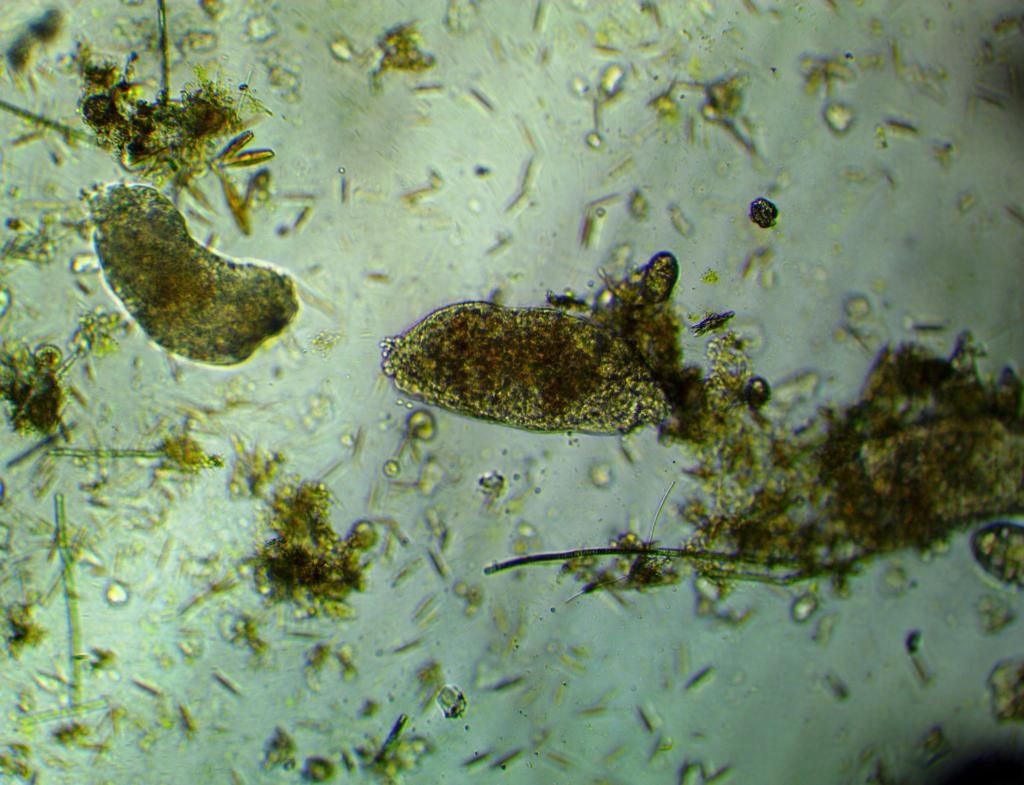
some wee beastie at 100x
they eat pretty much the same way the adults eat. they list to the side a bit, eye their food for a second, and then just snap it up. there is no chasing.
one thing that i have noticed is that the size of the mouths of the fry goes from a small opening to pretty much dominating their whole heads within a couple days. i think this would be when they grow the most. the first fry i saw was 11 days ago, and the one that i am keeping in a tiny container for observation has suddenly developed a large mouth withing the last day. its mouth opened up three days ago, and it was barely larger than the fishes pupil. now, it is larger than its whole eye.
ill try and get a pic. unfortunately, he wont stay still for very long.
not that that is a bad thing...
Edited by Auban, 07 October 2012 - 09:03 PM.
#15
 Guest_Auban_*
Guest_Auban_*
Posted 08 October 2012 - 05:16 PM
so far all the fry being given rinse water from mosses and such from my tanks are still alive. the detritous and such that forms along the bottom of the dish is easily wiped up with a piece of felt, so im able to remove almost everything that was added the day prior every time i feed/waterchange.
when i look at the detritous coming out and compare it to the detritous going in, there isnt much difference. one thing that does stand out is that most of the largest microbes are gone, but not all of them. another thing that seems to go missing is planaria, but i suspect that they just crawl off somewhere.
#16
 Guest_Auban_*
Guest_Auban_*
Posted 19 October 2012 - 11:58 PM
the first batch of fry are getting pretty big now. they are starting to look like actual fish.
#17
 Guest_Auban_*
Guest_Auban_*
Posted 22 November 2012 - 05:15 PM
siphoning the mulm off the bottom of the tank is working pretty good though, as i am still seeing small fish turn up in a tank i started adding the mulm too. to that tank i also add live food from the live food tub(which took off again after i removed the killifish). i think this is the easiest way for me to go about it. mulm and invisible gilberti fry go into a 20g breeder, and the dero worms, ostracods, daphnia and moina mix from the live food tub gets sent through a coffee filter and added to the fry tank. in a couple weeks it will be time to move the larger fry to another tank.
leaving the fry in a large tub without feeding them is fine for just a few fry, but they eat their food source too fast if they are left with it. i can raise more fry faster on the same amount of tanks if i keep the food separated from them and just practice normal feedings.
not very surprising results, but hey, i had to try it.
#18
 Guest_EricaWieser_*
Guest_EricaWieser_*
Posted 22 November 2012 - 08:04 PM
I'm glad that's working. I think you're right, that it's a good idea to remove the fry from the tank with their parents.well, i only have about 10 of my original fry left, total. they are all doing well, but my fry seemed to vanish from the live food bin that i had been putting them into. after tearing the tub down, i found two one inch long young bluefin killifish. they must have come in on the floating plants that i moved over from my main tank. lesson learned. either way, the fry that i have now are just about large enough to move over to the tank their parents are in.
siphoning the mulm off the bottom of the tank is working pretty good though, as i am still seeing small fish turn up in a tank i started adding the mulm too. to that tank i also add live food from the live food tub(which took off again after i removed the killifish). i think this is the easiest way for me to go about it. mulm and invisible gilberti fry go into a 20g breeder, and the dero worms, ostracods, daphnia and moina mix from the live food tub gets sent through a coffee filter and added to the fry tank. in a couple weeks it will be time to move the larger fry to another tank.
leaving the fry in a large tub without feeding them is fine for just a few fry, but they eat their food source too fast if they are left with it. i can raise more fry faster on the same amount of tanks if i keep the food separated from them and just practice normal feedings.
not very surprising results, but hey, i had to try it.
#19
 Guest_Auban_*
Guest_Auban_*
Posted 25 November 2012 - 06:16 AM
http://s1242.photobu...1125_023133.mp4
this is something i have been working on for the past couple months now. its an algae pad that im going to try lining a small tank with. if it works out, it will make an excellent fry tank. the stuff is visibly crawling with copepods.
two weeks ago, right after i added it to my wifes planted shrimp tank:
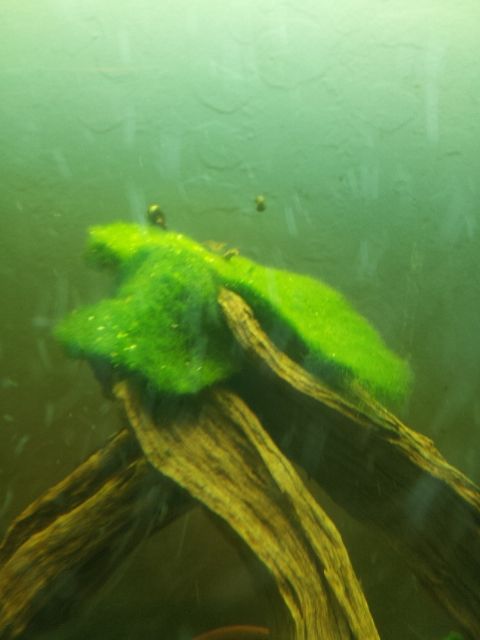
and this is what it looks like now:

i have to trim it every three days, but i think its working out pretty well. ill be ready to test it soon i hope.
#20
 Guest_EricaWieser_*
Guest_EricaWieser_*
Posted 25 November 2012 - 11:18 AM
The green fuzzy substrate in this tank started out as a cute contained little marimo ball:
http://img.photobuck...oreandafter.jpg
http://img.photobuck...imiru/058-1.jpg
The first sign of impending doom was this:
http://img.photobuck...30th2009017.jpg
a hanger on. It was not on the marimo ball. It just spontaneously appeared on a tank object that was near light. I stupidly watched it grow, not killing it. What should I have done? Killed it. Complete water change, completely cleaned everything. But maybe then it was too late; it had spored.
2 user(s) are reading this topic
0 members, 2 guests, 0 anonymous users







